Digs & Discoveries
Anchors Aweigh
By JASON URBANUS
Thursday, June 10, 2021
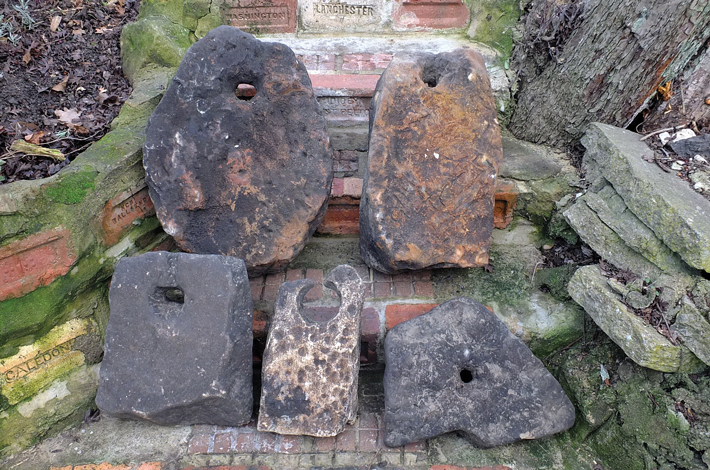 Divers exploring a section of the River Wear west of Sunderland, England, retrieved an assortment of Roman artifacts and nine ship anchors that had been buried in the riverbed for 2,000 years. Weighing up to 40 pounds, the stone anchors resemble other Roman examples found elsewhere in Britain, but these are the first to be discovered in a river and not a maritime context. Archaeologist Gary Bankhead believes the anchors may indicate the location of a small harbor or unloading zone once used by the Romans. “Seagoing ships would have been unable to go any further upstream due to the shallow depth of water at low tide, so cargo would have had to be transferred to smaller boats,” says Bankhead. The River Wear was likely an important supply route used by the Roman army to provision their forts farther upriver during their campaigns against northern British tribes.
Divers exploring a section of the River Wear west of Sunderland, England, retrieved an assortment of Roman artifacts and nine ship anchors that had been buried in the riverbed for 2,000 years. Weighing up to 40 pounds, the stone anchors resemble other Roman examples found elsewhere in Britain, but these are the first to be discovered in a river and not a maritime context. Archaeologist Gary Bankhead believes the anchors may indicate the location of a small harbor or unloading zone once used by the Romans. “Seagoing ships would have been unable to go any further upstream due to the shallow depth of water at low tide, so cargo would have had to be transferred to smaller boats,” says Bankhead. The River Wear was likely an important supply route used by the Roman army to provision their forts farther upriver during their campaigns against northern British tribes.
Tubman's Training Ground
By DANIEL WEISS
Thursday, June 10, 2021

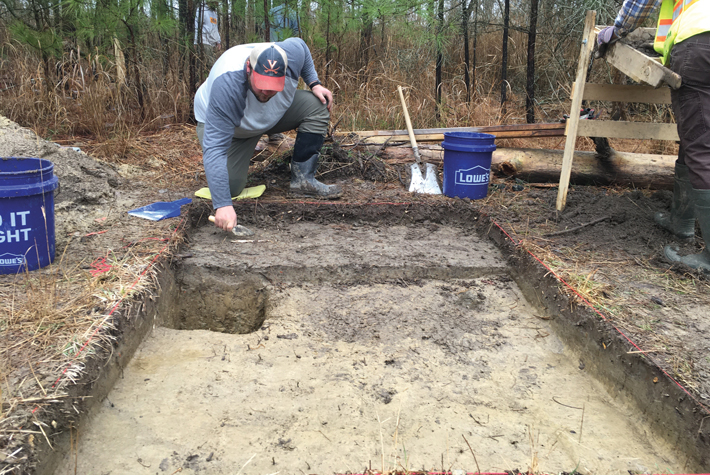 The site of the cabin where Harriet Tubman lived with her family as a young adult in the early 1840s has been located in the Blackwater National Wildlife Refuge on Maryland’s Eastern Shore. According to the will of his former owner, Tubman’s father, Ben Ross, was to be freed from slavery and granted 10 acres in the area. The precise location of his plot, however—referred to as “Old Ben’s Place” in later land deeds—was unknown.
The site of the cabin where Harriet Tubman lived with her family as a young adult in the early 1840s has been located in the Blackwater National Wildlife Refuge on Maryland’s Eastern Shore. According to the will of his former owner, Tubman’s father, Ben Ross, was to be freed from slavery and granted 10 acres in the area. The precise location of his plot, however—referred to as “Old Ben’s Place” in later land deeds—was unknown.
A recent excavation led by Julie Schablitsky, project director and chief archaeologist with the Maryland Department of Transportation, has unearthed a range of evidence of the cabin. This includes a coin dating to 1808 found on an old road leading to the site, ceramic sherds imprinted with dishware patterns popular in the 1820s to 1840s, and bricks, nails, and hinges thought to have been part of the cabin itself. While living there, Tubman likely gained important skills for her career as a conductor on the Underground Railroad. “The area is wet, swampy, full of bugs, and wooded,” Schablitsky says. “She was able to learn to navigate brutal terrain, providing confidence to lead her people through such harsh environments.” Tubman may also have gained pointers on making her way farther afield from free Black mariners who transported wood that her father felled and sold to shipbuilders in Baltimore.
Red Carpet Treatment
By MARLEY BROWN
Thursday, June 10, 2021
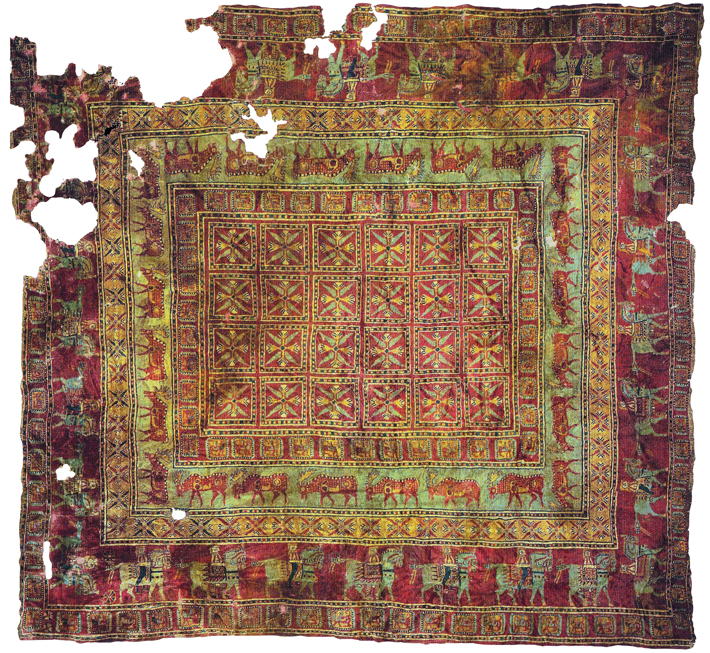 A member of the Pazyryk culture, a nomadic Scythian people who once roamed the mountainous terrain where present-day Russia, Kazakhstan, and Mongolia meet, was buried nearly 2,500 years ago with a textile featuring a rich tableau of lotus buds, deer, and cross-shaped figures. The textile, which measures roughly six feet on a side and was woven with more than 1,250,000 knots, is the world’s oldest known pile carpet. Since it was discovered preserved under a layer of permafrost in 1947, researchers have marveled at the carpet’s enduring hues of yellow, blue, and red.
A member of the Pazyryk culture, a nomadic Scythian people who once roamed the mountainous terrain where present-day Russia, Kazakhstan, and Mongolia meet, was buried nearly 2,500 years ago with a textile featuring a rich tableau of lotus buds, deer, and cross-shaped figures. The textile, which measures roughly six feet on a side and was woven with more than 1,250,000 knots, is the world’s oldest known pile carpet. Since it was discovered preserved under a layer of permafrost in 1947, researchers have marveled at the carpet’s enduring hues of yellow, blue, and red.
A team of scientists led by Andreas Späth and Rainer Fink from Germany’s Friedrich-Alexander University Erlangen-Nuremberg recently attempted to figure out how Pazyryk artisans or their trading partners produced such intense colors. They experimented with a method of fermenting wool before dyeing it. “The microorganisms that grow during fermentation eat up fat layers between the cuticle scales in wool fibers,” says Späth. He explains that these fat layers block the diffusion of most natural pigments into the fibers. When the fat layers are gone, that diffusion is strongly enhanced. The team was able to observe this effect using a high-resolution X-ray microscope on both the wool fibers they dyed in their experiment and those from a tiny sample of the Pazyryk carpet, suggesting that the fermentation technique was used to create the carpet’s dazzling colors.
Buddhist Retreat
By GURVINDER SINGH
Thursday, June 10, 2021
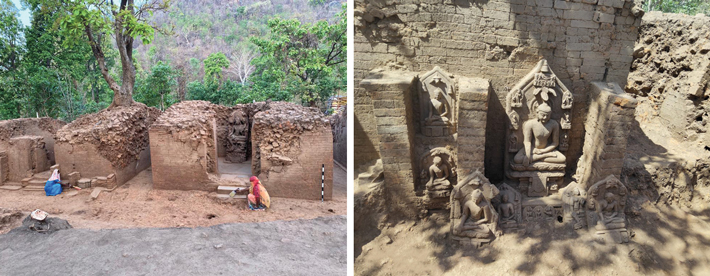 Archaeologists in the eastern Indian state of Jharkhand have unearthed a small vihara, an early type of Buddhist monastery. A team from the Archaeological Survey of India (ASI) investigating several mounds in a hilly area found a Buddhist shrine in one of them and the vihara in another. According to Rajendra Dehuri, ASI deputy superintending archaeologist, the monastery includes six rooms that open onto a wide veranda. Also found at the site were sculptures of Gautama Buddha, as well as the Buddhist deities Avalokiteshvara and Tara. The structure appears to have been built between the eighth and eleventh centuries A.D.
Archaeologists in the eastern Indian state of Jharkhand have unearthed a small vihara, an early type of Buddhist monastery. A team from the Archaeological Survey of India (ASI) investigating several mounds in a hilly area found a Buddhist shrine in one of them and the vihara in another. According to Rajendra Dehuri, ASI deputy superintending archaeologist, the monastery includes six rooms that open onto a wide veranda. Also found at the site were sculptures of Gautama Buddha, as well as the Buddhist deities Avalokiteshvara and Tara. The structure appears to have been built between the eighth and eleventh centuries A.D.
The Copper Standard
By MARLEY BROWN
Thursday, June 10, 2021
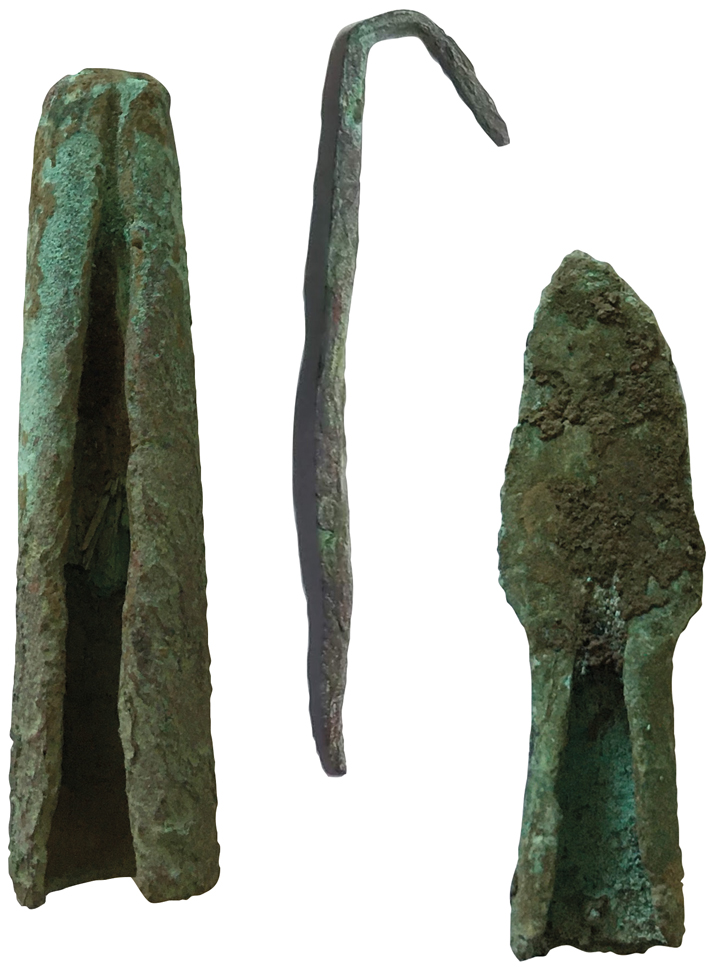 For millennia, hunter-gatherers living around Lake Superior created utilitarian objects such as projectile points, knife blades, and awls out of copper. Today, these Archaic period societies are collectively referred to as the Old Copper Complex (OCC). For reasons not entirely clear, the OCC emerged early in the Archaic period (9000–1000 B.C.) and disappeared sometime between 5,000 and 3,500 years ago. A range of dates has been suggested for when the OCC began. To better pin down when the OCC emerged, a team led by geologist David Pompeani of Kansas State University evaluated 53 radiocarbon dates associated with copper artifacts and ancient copper mines. They found that dates from wood and rope embedded in objects such as projectile points were most likely to reflect the time during which the objects were used, because these materials were preserved in their original context. “The oldest reliable age from embedded material in a copper artifact is about 8,500 years old,” says Pompeani. “Many other samples of embedded material have ages between 8,000 and 5,000 years ago.”
For millennia, hunter-gatherers living around Lake Superior created utilitarian objects such as projectile points, knife blades, and awls out of copper. Today, these Archaic period societies are collectively referred to as the Old Copper Complex (OCC). For reasons not entirely clear, the OCC emerged early in the Archaic period (9000–1000 B.C.) and disappeared sometime between 5,000 and 3,500 years ago. A range of dates has been suggested for when the OCC began. To better pin down when the OCC emerged, a team led by geologist David Pompeani of Kansas State University evaluated 53 radiocarbon dates associated with copper artifacts and ancient copper mines. They found that dates from wood and rope embedded in objects such as projectile points were most likely to reflect the time during which the objects were used, because these materials were preserved in their original context. “The oldest reliable age from embedded material in a copper artifact is about 8,500 years old,” says Pompeani. “Many other samples of embedded material have ages between 8,000 and 5,000 years ago.”
As to why one of the world’s oldest metalworking traditions was abandoned, archaeologist Michelle Bebber of Kent State University believes that copper blades and projectile points did not offer enough of an advantage over stone versions to warrant the greater effort involved in making them, particularly as populations grew and resources diminished. People needed more time to hunt and defend their territory, Bebber suggests, and may have repurposed copper for use in trade or as gifts.
Advertisement
Advertisement
IN THIS ISSUE
Digs & Discoveries
A Challenging World
The Spider's on the Wall
Mirror, Mirror
Return to Sender
The Copper Standard
Red Carpet Treatment
Buddhist Retreat
Tubman's Training Ground
Anchors Aweigh
In the Anatolian Arena
Lost Egyptian City
Laws of the Land
Bathing at the Bar
Off the Grid
Around the World
Ancient Australian multi-tools, Africa’s oldest house, Neanderthal hygiene, and Viking warrior bedding
Artifact
All wonders great and small
Advertisement

Recent Issues
-
 May/June 2024
May/June 2024
-
 March/April 2024
March/April 2024
-
 January/February 2024
January/February 2024
-
 November/December 2023
November/December 2023
-
 September/October 2023
September/October 2023
-
 July/August 2023
July/August 2023
-
 May/June 2023
May/June 2023
-
 March/April 2023
March/April 2023
-
 January/February 2023
January/February 2023
-
 November/December 2022
November/December 2022
-
 September/October 2022
September/October 2022
-
 July/August 2022
July/August 2022
-
 May/June 2022
May/June 2022
-
 March/April 2022
March/April 2022
-
 January/February 2022
January/February 2022
-
 November/December 2021
November/December 2021
-
 September/October 2021
September/October 2021
-
 July/August 2021
July/August 2021
-
 May/June 2021
May/June 2021
-
 March/April 2021
March/April 2021
-
 January/February 2021
January/February 2021
-
 November/December 2020
November/December 2020
-
 September/October 2020
September/October 2020
-
 July/August 2020
July/August 2020
-
 May/June 2020
May/June 2020
-
 March/April 2020
March/April 2020
-
 January/February 2020
January/February 2020
-
 November/December 2019
November/December 2019
-
 September/October 2019
September/October 2019
-
 July/August 2019
July/August 2019
-
 May/June 2019
May/June 2019
-
 March/April 2019
March/April 2019
-
 January/February 2019
January/February 2019
-
 November/December 2018
November/December 2018
-
 September/October 2018
September/October 2018
-
 July/August 2018
July/August 2018
-
 May/June 2018
May/June 2018
-
 March/April 2018
March/April 2018
-
 January/February 2018
January/February 2018
-
 November/December 2017
November/December 2017
-
 September/October 2017
September/October 2017
-
 July/August 2017
July/August 2017
-
 May/June 2017
May/June 2017
-
 March/April 2017
March/April 2017
-
 January/February 2017
January/February 2017
-
 November/December 2016
November/December 2016
-
 September/October 2016
September/October 2016
-
 July/August 2016
July/August 2016
-
 May/June 2016
May/June 2016
-
 March/April 2016
March/April 2016
-
 January/February 2016
January/February 2016
-
 November/December 2015
November/December 2015
-
 September/October 2015
September/October 2015
-
 July/August 2015
July/August 2015
-
 May/June 2015
May/June 2015
-
 March/April 2015
March/April 2015
-
 January/February 2015
January/February 2015
-
 November/December 2014
November/December 2014
-
 September/October 2014
September/October 2014
-
 July/August 2014
July/August 2014
-
 May/June 2014
May/June 2014
-
 March/April 2014
March/April 2014
-
 January/February 2014
January/February 2014
-
 November/December 2013
November/December 2013
-
 September/October 2013
September/October 2013
-
 July/August 2013
July/August 2013
-
 May/June 2013
May/June 2013
-
 March/April 2013
March/April 2013
-
 January/February 2013
January/February 2013
-
 November/December 2012
November/December 2012
-
 September/October 2012
September/October 2012
-
 July/August 2012
July/August 2012
-
 May/June 2012
May/June 2012
-
 March/April 2012
March/April 2012
-
 January/February 2012
January/February 2012
-
 November/December 2011
November/December 2011
-
 September/October 2011
September/October 2011
-
 July/August 2011
July/August 2011
-
 May/June 2011
May/June 2011
-
 March/April 2011
March/April 2011
-
 January/February 2011
January/February 2011
Advertisement






